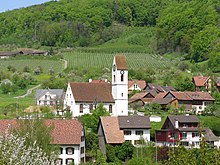Corn language
| Corn language | |
|---|---|
| State : |
|
| Canton : |
|
| District : | Sissach |
| BFS no. : | 2853 |
| Postal code : | 4464 |
| Coordinates : | 630 765 / 263 839 |
| Height : | 371 m above sea level M. |
| Height range : | 350–636 m above sea level M. |
| Area : | 5.08 km² |
| Residents: | 922 (December 31, 2018) |
| Population density : | 181 inhabitants per km² |
| Website: | www.maisprach.ch |
|
Corn language |
|
| Location of the municipality | |
Maisprach ( Swiss German : Maischberg , [ ˈmaɪʃbə̆ɾɡ ]) is a municipality in the district of Sissach in the canton of Basel-Landschaft in Switzerland .
geography

Maisprach is embedded in a valley floor on the southern slope of the Sonnenberg and is the northernmost village in the Upper Basel area .
history
The first mention of the place Meissprache goes back to the year 1180. In 1247 the name had evolved into Mesbrache . The place name could contain the Celto-Roman ending -acus . Another possible explanation sees this as an Old High German place names: Meginesbrâcha that Brachfeld of Megin. An early historical defense system was on the Sunnenberg . On the Hübel there was a Roman villa from the 2nd century, which extended to the present cemetery.
In the cemetery wall just below the church are the remains of a stone house from the high Middle Ages, which can probably be considered a royal estate. In the Middle Ages there were two large farms next to the village. One belonged to the German Empire until 1360, the other to the Bishop of Basel . The village itself, together with the patronage law, was owned by the Counts of Thierstein in 1322 and belonged to the Farnsburg lordship , which in 1461, including the village and the two farms, was sold to the city of Basel . At the beginning of the 16th century, the right of patronage to the church was also transferred to Basel.
In 1546 a fire destroyed almost the whole village. Viticulture is of particular importance (see coat of arms). Finds show that viticulture was already practiced here in Roman times. Viticulture was first mentioned in documents in 1328. In the 18th century the silk ribbon industry began to play an important role. In the 19th century the watch stone grinding shop was established.
coat of arms
Maisprach has had an official coat of arms since 1944. It is divided into two halves by a vertical line. The two halves each show a bunch of grapes. On the right it is red on a silver background, on the left the grape is silver on a red background. The coat of arms represents the importance of viticulture in the community.
Attractions
- Parish Church of St. Maria: previous buildings from the 8th to 10th century; First mentioned in 1291; 1700 nave, 1711 tower and choir rebuilt.
- Residential house at Möhlinstrasse 13, built in the middle of the 18th century
literature
- Hans-Rudolf Heyer: The art monuments of the canton of Basel-Landschaft, Volume III: The district of Sissach. Edited by the Society for Swiss Art History GSK. Bern 1986 (Art Monuments of Switzerland, Volume 77). ISBN 3-7643-1796-5 . Pp. 139-159.
Web links
- Community information Maisprach on bl.ch
- André Salvisberg : Maize language. In: Historical Lexicon of Switzerland .
Individual evidence
- ↑ Permanent and non-permanent resident population by year, canton, district, municipality, population type and gender (permanent resident population). In: bfs. admin.ch . Federal Statistical Office (FSO), August 31, 2019, accessed on December 22, 2019 .




